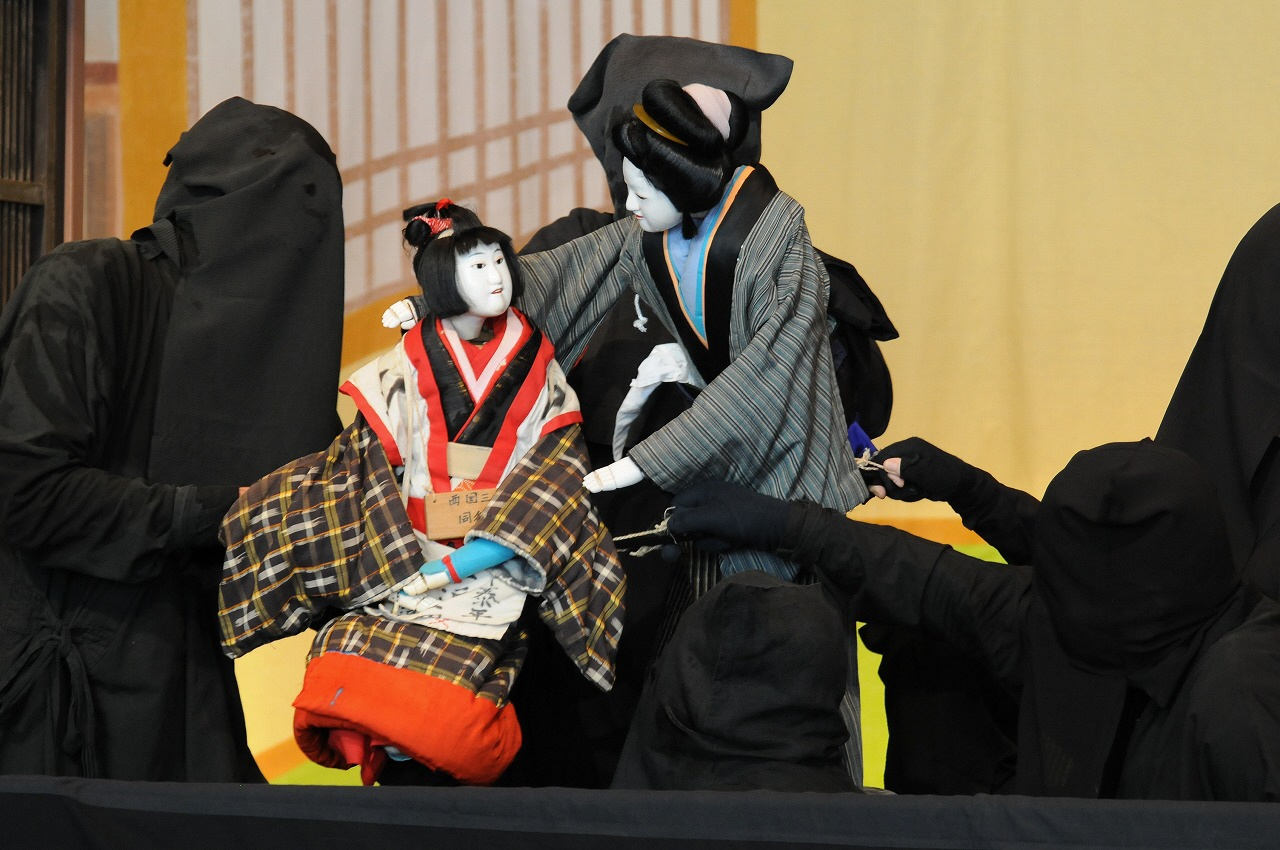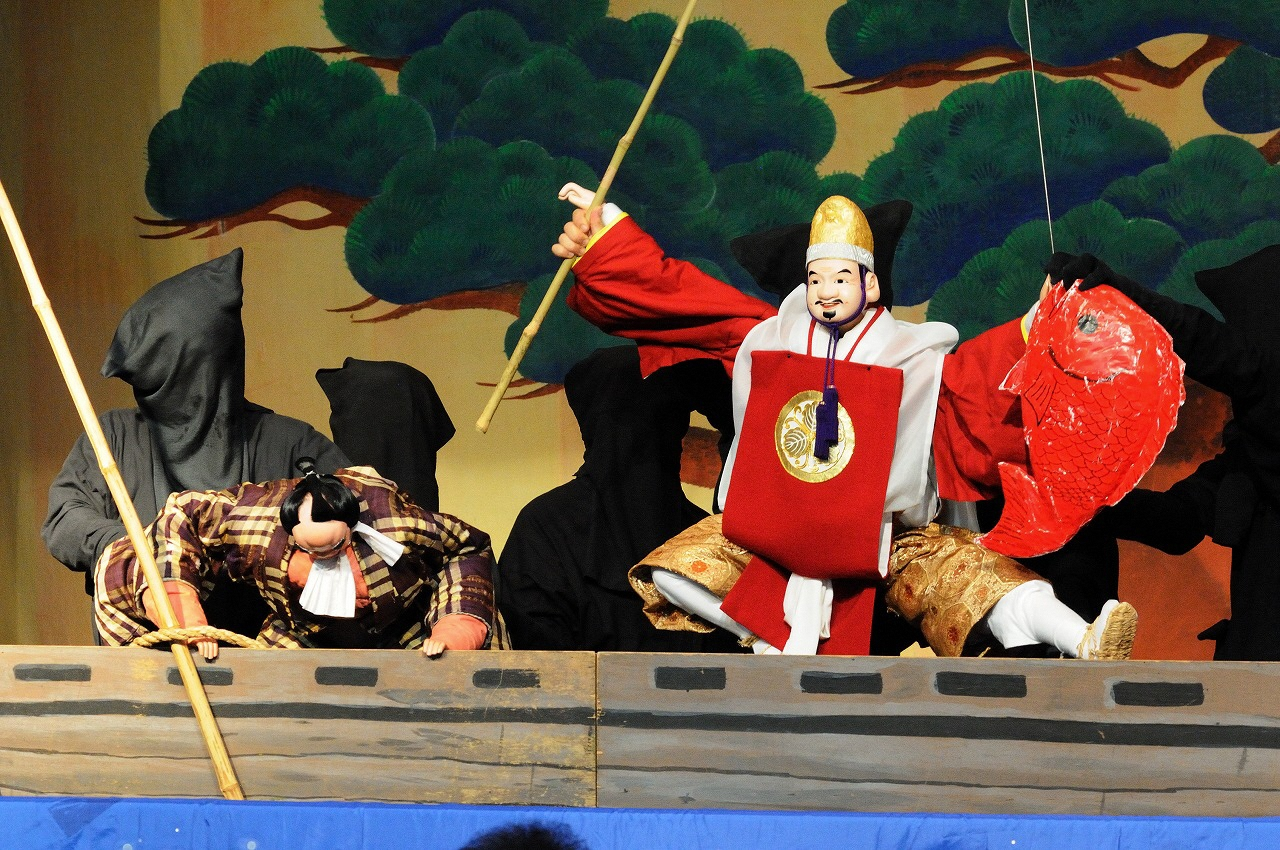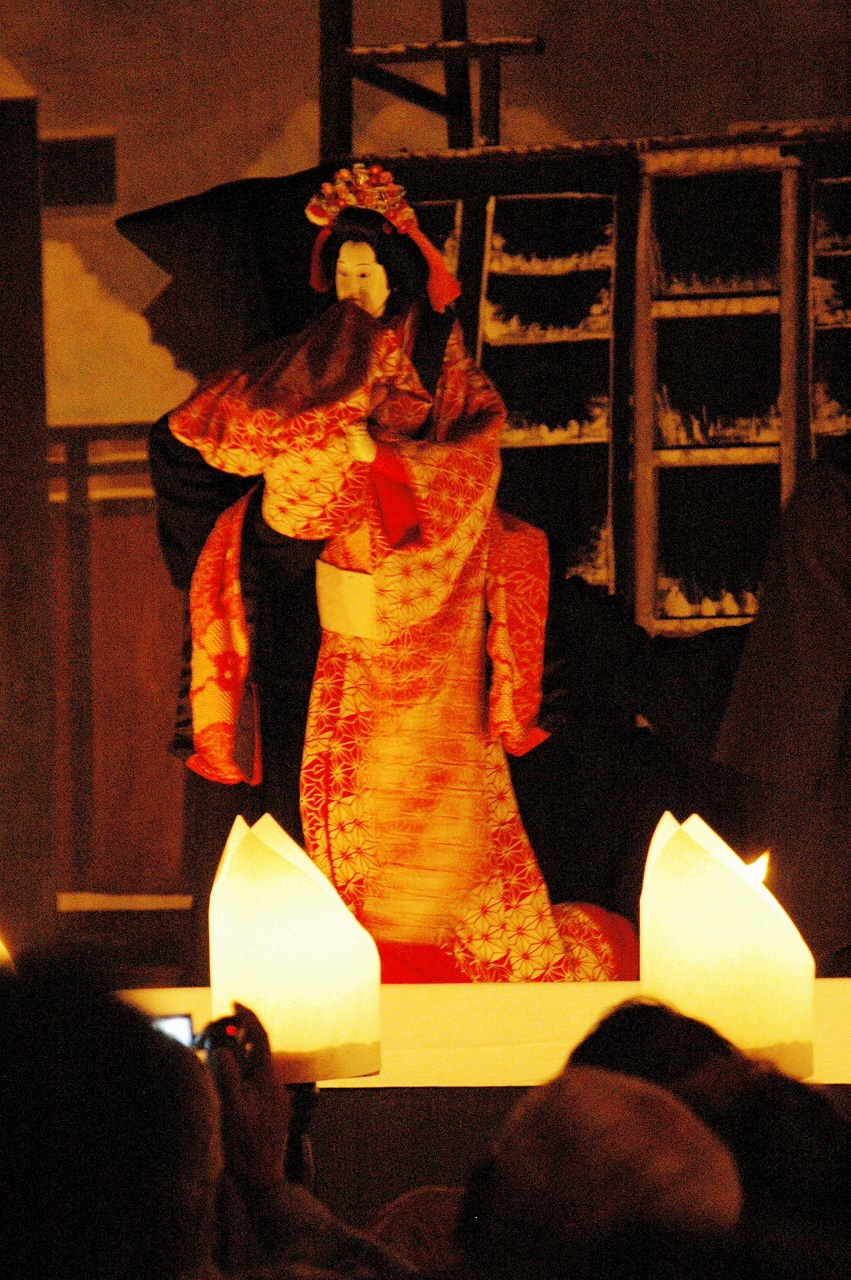本文
imada puppet play
Imada Puppet Play
Imada Puppet Play
Division: Iida City Intangible Cultural property (appointed Heisei 2 (1990), November 14th)
"Imada Puppet" selected as Nagano prefecture’s Intangible Folk Cultural Property
Location: Tatsue, Iida city
Overview :

They perform a three-person operation of the puppet Joruri. The three-person operation is a unique Japanese puppet manipulation method by three person who become one body, the Omozukai is manipulating the Kashira and the right hand, the Hidarizukai manipulates the left hand and the Ashizukai, the legs. Joruri means theatrical music in which shamisen is used as an accompaniment instrument, and a role called Tayu speaks lines and narrates the story.
Regarding its beginning, it is written in an ancient document titled "The Beginning of Puppet Manipulation in our village" that the first year of Hoei (1704) was an era of one-person puppet manipulation.
The current three-person operation style was first performed in Kyoho 19 (1734) in Osaka but, it is believed that it was later spread to the Ina valley via the highway and it became professional puppet plays performed all over Japan.
Imada puppet has survived many life-threatening crises and is currently the puppet theater group with the highest number of successors to pursue their activities in the Ina valley. They are popular for their unique performances by the light of Japanese candles staring in Heisei 2 (1990).
They possess 90 puppet kashiras.
Including Imada Puppet, Kuroda puppet (Iida City Intangible Cultural Property) and Waseda puppet theater (Shimoina district, Anan city) as Ina’s puppet theaters have been chosen by the government as intangible folk cultural property that should be documented.
*A Joruri play is a traditional Bunraku play including songs
*A Kashira consists of the head and neck (neck rod)
Puppet mechanisms and manipulation
A puppet is the assemblage of a Kashira, torso, hands and legs wearing a costume. The Kashira is mainly carved in cypress wood, split in two and hollowed out on the inside to add techniques to move the eyes, eyebrows, mouth, nose, etc... The puppet’s movements are controlled by the strings attached to the torso attached under the head. The hands and legs are hung to strings attached to the body’s shoulder plate attached to the head. There is a wide variety of Kashiras, hands and legs depending on the role. The women puppets usually do not have legs.
Imada puppet does a three-person puppet manipulation. The Omozukai is manipulating the Kashira holding the neck rod in his left hand and the right hand with his right hand, from behind the puppet. The main puppeteer is the only one to wear stage getas adapted to his height.
The Hidarizukai controls the puppet’s left hand with his right hand and handles props with his left hand.
The Ashizukai manipulates the legs with both hands and reproduce footsteps sound by stomping with his sandals. For the women roles, the footsteps are expressed by pinching the hem of the clothes from the inside.
Play titles
Imada puppets have the following play titles but, the ones actually performed might differ from time to time.
"The Ceremonial Sanbaso Dance", "Hiyoshimaru and the Young Cherry-Tree", "Imperial Palace Cherry Blossoms and the Horikawa Night Attack – Benkei the Emissary", "The Dish Mansion at Bancho‐Aoyama Tetsuzan", "Sugawara and the Secrets of Calligraphy – The Village School", "The Nine-Tailed Fox, 2nd act - Michiharu’s Mansion", "Chronicle of the Battle of Ichinotani - The Suma Beach", "The Ridgepole of the Sanjusangendo temple – Heitaro’s House", "The Adachi Plain in Oshu-Sodehagi’s Appeal", "Japan’s 24 Paragons of Filial Piety - The Ten Fragrances", "A Tragedy of Tokushima - The Pilgrim Song", "Mt Imo and Mt Se: A Tale of Womanly Virtue", "Sankatsu and Hanshichi – The Sake Shop Scene", "Three Generations of Kamakura- Miura Tokihime", "Horikawa, Oshun Denbei- The monkey trainer", "A Picture Book of the Taiko Hideyoshi, 10th act – Amagasaki", "The Miracle at Hakone, Shindo Katsugoro – The Waterfall", "Akogi Bay- Heiji’s House", "Shank’s Mare - Akasaka Namiki", "The Miracle at Tsubosaka temple – From Sawaichi’s house to the shrine", "The Disputed Succession of the Date Family – Masaoka’s Loyalty act", "Ebisu dance", "The Story of the Morning Glory – From the Inn to the Oi River", "Oshichi’s Burning Love, Oshichi’s Fire Tower act", "The Crossing at the Hidaka River, The Ferry Crossing act", "Kotaro’s Tale" (original work), "Twilight Crane" (Kinoshita Junji’s work)
The history of Imada puppet and those who worked hard to inherit from it

It is said that Imada Puppet started around the time of the first year of Hoei (1704), when they were one-person puppeteer. The first year of Hoei follows the year of the great success of the first performance of "The Love Suicide at Sonezaki", written by Chikamatsu Monzaemon (*1), by the Takemoto company of Osaka, which was the center of puppet Joruri. Takemoto Gidayu even traveled to Nagoya to perform. It is believed that information acquired at that time was brought to the Ina valley through the Chuma highway(*2).
It is said that the unique Japanese technique called three-person operation of the puppet started in Kyoho 19 (1734) in Osaka, but later when kabuki became popular and it lost its audience, puppeteers from Awaji and Osaka began to focus on touring local regions. From the late Edo period to the Meiji period, puppeteers from Awaji and Osaka visited the Ina valley and transmitted their excellent techniques making people grow.
During the modernization, the puppet theater was also in a difficult period, particularly before and after the Second World War in the Showa era, it was a life-death crisis.
What happened for Imada Puppet is around Showa 12 (1937) they became a group of only 4 persons, 3 puppeteers and 1 Tayu. Furthermore, after the war, old things were avoided.
In this situation, Mr Kinoshita Sen studied the local puppet theater, bought and replenished puppet show equipment, and the year following his nomination as the mayor of Tatsue in Showa 29 (1954), he created the Tatsue community center’s Puppet department. Moreover, in Showa 29 (1954) in an effort to preserve and pass on local performing arts, Imada Puppet came together with Kuroda puppet and Waseda puppet (Anan city) to establish the Ina Puppet Preservation Council...
The elder son of Sen, Kinoshita Michihiko, created and performed an easy-to-understand version of "Twilight Crane", opening the doors of the puppet troupe performing in shrines which was limited to local people, against the opposition of the elderly. In addition, while learning excellent bunraku (*3) techniques, he also valued the unique techniques of Imada Puppet. Furthermore, in Showa 53 (1978) the Ryukyo Junior High School Local Club, the Imada Puppet group (later the Imada Puppet Club) was created and he invested himself in teaching too. In Showa 58 (1983), he launched again the "Ina Valley 4 Troupes Puppet Theater Joint Presentation (later the Ina Valley Puppet Theater Preservation Council)", which disappeared after Mr Sen, performances to the light of Japanese candles reminiscent of the Edo period were also tried.
Kinoshita Michihiko who worked hard in this way, not only on the preservation and heritage of Imada Puppet but of the whole Ina Valley puppet theater, passed away in an unexpected accident in Showa 63(1988).
However, Imada Puppet roused itself to action and continued its activities. Two of Michiko’s students, Tsuruzawa Seishiro as a shamisen player and Yoshida Minoyuki as a puppeteer, are active in the Puppet Joruri Bunraku, the UNESCO Intangible Cultural Heritage (so-called World Heritage) which Japan boasts to the world. Imada puppet has grown to be the puppet troupe with the most successors in the Ina valley.
There are comments about the puppet structures, play titles, history, etc... on the Imada Puppet website.
*1 Chikamatsu Monzaemon: He is a playwright during the Edo period, who produced Kabuki and puppet theater hit performances "The Love Suicide at Sonezaki", "The Battles of Coxinga", etc... with a method of performance mixed with songs called Joruri.
*2 Chuma highway: Mainly from the Edo to the Meiji period, in order to transport necessary supplies like salt, farmers used horses, this transportation developed inland is called Chuma. Iida was at the intersection of the Sanshu, Enshu and Ohira highways.
*3 Bunraku: The Joruri performed by the bunraku troupe created by Uemura Bunrakuken from Awaji, has been designated as an Important Intangible Cultural Property of Japan and registered as a UNESCO Intangible Cultural Heritage (known as World Heritage). According to the Bunraku association, they performed mainly at Osaka’s National Bunraku Theater.
Visit-transport access
3rd Saturday and Sunday of October, performance dedicated to the Omiya shrine Grand Autumn Festival.
- 20 min by car from Iida city area
- JR Iida line "Tenryukyo" 18 min by walk "Tokimata" 22 min by walk
- Shinnan transport city bus Chiyo line "Ippongi" 5 min by walk
Perform at the Iida Puppet Theater Festival starting in August.
Related website – Guidebook
Iidatube.tv (culture hall subsite)(外部リンク)
"graphic Imada Puppet" Imada Puppet Company 1999
"Imada puppet plays Iida city local performing arts research report" Iida city board of education 1973

